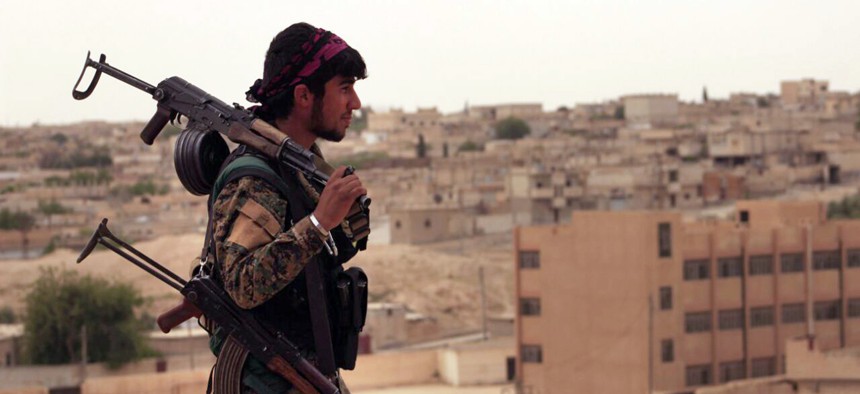
A Syrian Democratic Forces fighter carrying weapons as he looks toward the northern town of Tabqa, Syria, Apr 30, 2017. Syrian Democratic Forces, via AP
So Trump Is Arming Kurds...Then What?
Trump’s latest decision orders more US military intervention than Obama wanted. The more Americans and allies fight this war, the more they deserve a plan for the peace.
An overnight decision months in the making is now official U.S. policy: America will directly arm the Syrian Kurds. NATO ally Turkey may see Syrian Kurdish fighters as terrorists, but the Pentagon sees them as the most effective local force in the fight against the Islamic State, or ISIS. Now they will have the weapons they need to push that fight into Raqqa.
Once again, President Donald Trump has taken up a question for further military intervention under consideration by the Obama administration and responded “yes.” But this latest approval for greater use of American force is just the start of the answers to the Syrian question that are needed now. The “…and then what?” question we keep hearing from senior military leaders overseeing troops in the Middle East is urgent and pressing. Troops on the ground and Americans back home would benefit from hearing the administration's answers.
They begin here: What happens after Raqqa? You can kill ISIS fighters, but it is far harder to slay an ideology, as military leaders have said for years and as U.S. Central Command’s Gen. Joseph Votel warned in this January report. So what is the military and non-military plan for post-ISIS Syria? Much like his predecessor, Trump has stated his desire to stay away from nation-building overseas. But without engaging in that 14-letter word which has come to be seen as a four-letter word, how will the United States make certain its forces don't have to return again to confront the next incarnation of ISIS? Who takes over Syrian security from the U.S.-led military coalition once the military campaign ends? Is it possible that ISIS can be eradicated while Syrian President Bashar al-Assad remains?
The long march which led to this policy shift began with the Obama administration’s desire to avoid extensive deployment of U.S. ground forces to fight wars in the Middle East. The idea was that U.S. forces would no longer send tens of thousands to fight wars in the region, but instead would fight “by, with and through” capable local forces already in the battle. America would help but not lead or take the brunt of the fight.
Initially, America found few forces to work with that were distant enough from al-Qaeda and capable enough on the battlefield. The Syrian Kurdish forces, despite their Marxist views and commitment to establishing their own homeland, were both. So began the unlikely alliance between the United States military and forces the Turkish government views as terrorists against whom it has waged decades of war. And since 2015, that relationship has deepened as U.S. special operations forces train, assist, and now equip a fighting force it views as competent and capable enough to help defeat ISIS, regardless of geopolitics.
The push to arm the Syrian Kurds directly began months ago as a policy change considered by the Obama administration. At the time, however, safeguarding the stability of the Turkish relationship trumped all, as the Obama administration inched the authorities forward. With President Donald Trump in the White House and the run-up to Raqqa imminent, America has at long last delivered on the promise Syrian Kurds most wanted to see fulfilled, arming them more adequately and openly to fight ISIS. That the Syrian Kurds are seeking their own homeland is no secret, but one that the U.S. is not contending with right at the moment as the fight against the so-called Islamic State takes priority above nearly all else.
So… and then what? Front and center, and urgently demanding policy makers’ attention and public explanation is what happens the day after ISIS falls and flees its current stronghold of Raqqa? What happens if Syrian Kurds must stay to act as a stabilization force after ISIS goes? What kind of governance is possible if a minority force far from home is left with the weapons and the terrain? How will Turkey, which has vocally registered its unhappiness with American proximity to its enemies, react to seeing Syrian Kurds occupy legitimizing international headlines as they help lead the charge to rout America’s most visible enemy? What kind of civilian governing structure will take over from these military liberators and keep out al-Qaeda, ISIS, or any future terrorist organization?
How many more U.S. troops will America ask to lay their lives on the line for these gains? How will Trump ensure the gains for which they sacrificed remain? How will Trump keep this war ended?
The president so far has chosen to be a far more hands-off commander in chief than his predecessor, delegating to America’s top military commanders when to keep sending Americans to fight and how many forces are needed on the battlefield. But there are no solid answers yet coming from the Trump administration leaders charged with either crafting or carrying out U.S. national security policy, only broad references to the importance of local governance in creating a peace that has any chance of lasting. As senior American officials have said recently, the military piece is in some ways the clearest and most easily communicated part of U.S. policy in Syria. The trick will come in turning the military campaign against ISIS into something more than just an ephemeral win along the way to an indefinite quagmire.
The task still before the Trump administration is to explain how arming Syria Kurds makes America safer, fits into its plan to reach the end of the ISIS War and the Syrian civil war, and – as the president pledged last year -- eventually brings America’s troops home.




